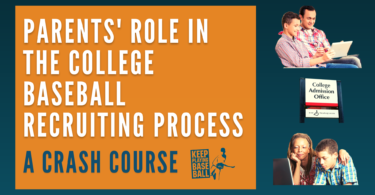This past year we got more questions than ever from recruits who are hungry to play college baseball. The recruits need help answering common concerns and practical questions, in addition to general advice on how to successfully navigate the recruiting process. Many players ask the exact same question, but almost all questions can be filed under the same themes. We also do annual surveys to find out more about the common concerns of the high school player and what they don’t understand about the recruiting process. In this article, we’ve put all these questions and research together to come up with 10 of the most common questions about the recruiting process and provide answers to them.
1. How do I make sure that college coaches don’t miss me?
Short Answer: If you are following along with KPB resources, doing things at the appropriate time, and being proactive with the recruiting process, you are not going to get missed– period. Most players that feel like they “got missed” or “never got seen” fail to get recruited because they sat back and waited for coaches to reach out or targeted the wrong programs/levels for their academic and athletic skill set. Being realistic about your abilities and the schools you target is extremely important in the recruiting process. If you don’t want to get “missed”, be open to all options, cast a wide net when you reach out to schools, and make sure you are proactive in the recruiting process. We discuss these ideas at length in the articles below.
Important Resources: Proactive Recruits Don’t Get Missed, Common Barriers to Recruitment
2. What’s the best way to contact coaches?
Short Answer: While social media DM’s are becoming more popular with younger coaches, email is still the preferred method for initiating contact with college coaches. In fact, of the dozens of college coaches we surveyed the last two years, almost all of them said they prefer that players contacting them for the first time do it through email. Emails should always be personalized and include only the information that is most useful to college coaches. This is not something you should do hastily. Details matter a great deal to coaches reading introductory emails, so craft them carefully and read them over more than once. Check with the resources below for how and when to contact college coaches to increase your chances for getting recruited.
Important Resources: Contacting College Coaches The Right Way: Introductory Emails, When to Contact College Coaches, Tips for Communicating With College Coaches, Prepare for Contact with College Coaches, Contacting Coaches and Seeking Exposure
3. How do I get a scholarship?
Short Answer: The truth is that many college baseball players don’t get athletic scholarships. As an equivalency sport, baseball is limited in the number of scholarships that a team can offer. Each level of college baseball has a different number of scholarships that each team can give out, but almost no one earns a full-ride on athletic money alone. It’s likely that a scholarship that you do get will only cover a portion of your cost of attendance. Getting good grades and scores on standardized tests are the best way to get more financial assistance when paying for school. We break down the topic of scholarships at length on the website and because it is complex, the best thing to do is use the long answer resources below or search the site!
Important Resources: Video: College Baseball Scholarship Basics, College Baseball Scholarship Limits and Rules: Level-by-Level, Making Sense of Your Scholarship, How to Balance Spending and Exposure in Search for Scholarships, More Scholarship Articles
4. When should I make a commitment?
Short Answer: The recruiting process is different for every player. Every player develops and matures at different rates and so there will be a lot of variation in when certain milestones occur for recruits, committing included. What is clear is that players who hold off on their commitment until their junior and senior year are less likely to deal with decommitment issues, changes to the terms of scholarships, and coaching changes at the school. In short, there’s no rush to make a commitment and you should be focused on the timing that makes sense for you. Don’t waste your time comparing yourself to your peers or worrying about when others are committing, focus on improving on a daily basis and reaching the standards for the level of college baseball that you hope to play. Since this is a complicated question with no easy answer, be sure to read the resources below which can really help you find the right timing for you to make the big decision!
Important Resources: Ready to Commit? A List of Things to Consider, Timing is Everything: Understanding the Recruiting Timeline, Patience Pays Off, Don’t Commit Until You’re 100% Ready, Committing Before Being Accepted , The Truth About Verbal Commitments, Handling Your Commitment the Right Way, Podcast: Verbal Commitments and Signing
5. When is the best time to go to a showcase?
Short Answer: Showcases are most helpful for getting recruited if you attend them when you have the skills and tools that college baseball coaches are looking for. When players attend showcases before they have a recruitable skillset, they are wasting their money. Before attending a showcase you should always do your research on who is running it and what the event will have. There are plenty of ways to create exposure that aren’t as expensive as showcases and showcases aren’t a necessity for getting recruited, although attending the right one at the right time may help.
Important Resources: The Truth About Showcases, How to Balance Spending and Exposure in the Search for Scholarships, Why You Should Delay Showcases Until You Are Ready, Summer Decisions: Showcases, Getting Noticed at Camps and Showcases
6. Do I need to have a recruiting video and should I pay to have someone make it?
Short Answer: Yes, you need a recruiting video and no, you shouldn’t pay to have someone make it. Recruiting videos or skills videos are an extremely useful and cost-effective way to create exposure and you should make sure you have an updated video to share with college coaches. The best part about recruiting videos is with a smart phone and a teammate or two, you can make a quality skills video yourself. It doesn’t have to be fancy and it doesn’t have to be edited well, it just needs to show college coaches enough that they’ll want to see more. We describe exactly what coaches want to see and how to make your own recruiting video in the resources below.
Important Resources: Everything You Need to Know About Recruiting Videos, How to Make Your Own Successful Recruiting Video, What to Include in a Pitching Recruiting Video, What to Include in a Position Player Recruiting Video, More Video Resources
7. What are the differences between the various levels and how do I know which one I should try to play?
Short Answer: Targeting the right levels is extremely important in the recruiting process. There is quality baseball at every college level, but there are some major difference among the divisions and levels. The best way to figure out which level you should target is by seeking honest and objective feedback from someone who knows college baseball well on a regular basis. The types of programs that express interest in you will also demonstrate which levels are appropriate for you to target. For example, if you are receiving interest from D1 programs, it’s safe to assume you can target similar programs and divisions below that.
Important Resources: College Levels and Divisions: What’s The Difference, Meeting the Standard of Play, Get Out to a College Game, Recruiting Rules: Level-by-Level, Scholarship Limits and Rules by Level
8. What’s more important for my recruitment, playing travel ball or high school ball? Public high school or private high school? Good high school program or bad high school program?
Short Answer: We get these types of questions all the time. Private or public? High school or travel ball? Good high school program or the one closest to our house? The truth is there are many paths to college baseball. The more diverse your recruiting process and the more ways you can connect with coaches the better but there is not one single path to the college game. All levels of college baseball are littered with players from public high schools, private high schools, good high schools, bad high schools, players who played travel ball, players who only played high school. Simply put, there is no one path or magic recipe to get there. We often tell players and parents who ask these questions 3 things: 1) Skill trumps everything (except poor academics) in recruiting, so if you are somewhere you can develop and get better you are in good shape– focus on being as skilled as possible and don’t worry as much about what you can’t control; 2) There are no absolutes or guarantees no matter which route you take but we are confident in saying that, regardless of where you come from and the resources you have, if you have the right info and come up with a plan, you can make it to any level of college baseball; 3) Nothing is final and you can always change if something really isn’t working out.
Important Resources: What’s Better for Recruiting: High School or Travel Ball?, Importance of a Diverse Recruiting Plan,
9. What kind of things are college coaches looking for and what are the necessary skills for playing college baseball at my position?
Short Answer: Every college coach will be looking for something slightly different, but every coach wants a high character player with good grades, athleticism, and tools. You can bank on college coaches watching everything from the way you interact with family and your body language to the way you warm up and perform in big situations. Everything matters, so be the best version of yourself at all times. As far as positional skills, each position will have a set of standards that players are expected to perform at and unique skills and abilities that must be performed. We break each position down in the article below.
Important Resources: What it Takes to Make the Team: Position-By-Position, Recruiting Lessons from a Player Like You
10. What does it mean to be a walk-on?
Short Answer: A walk-on player used to be someone who literally walked up to the field and joined the team. Those opportunities, however, are all but gone at most colleges and universities. Today, a walk-on most commonly refers to a non-scholarship player or a player without a guaranteed roster spot. However, there are many different kinds of “walk-ons” and each walk-on opportunity will carry different risks and levels of certainty. Some common types of walk-ons are “recruited walk-ons” (players who are recruited to the team, have no scholarship and have either been guaranteed a roster spot or are competing for a roster spot without a guarantee) and “blind walk-ons” (players who, in traditional fashion, enroll at school and show up wanting to play). Before taking a walk-on spot, you’ll want to make sure you are clear on the details.
Important Resources: Walking On: The Real Story






